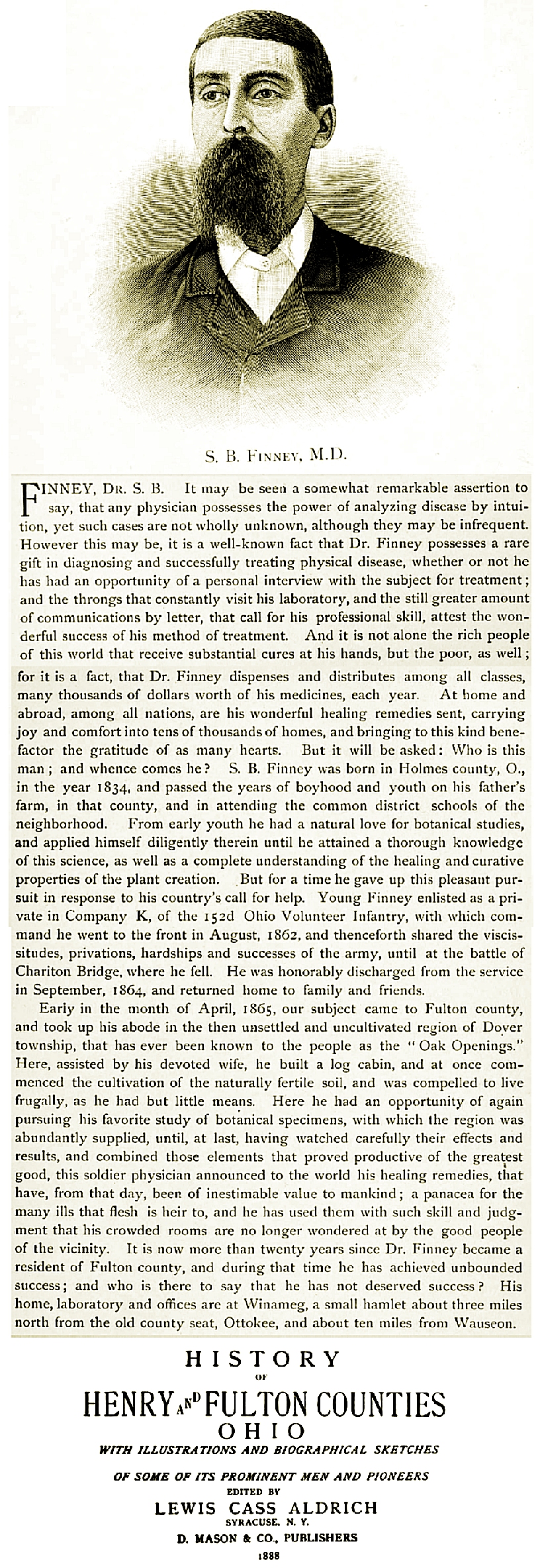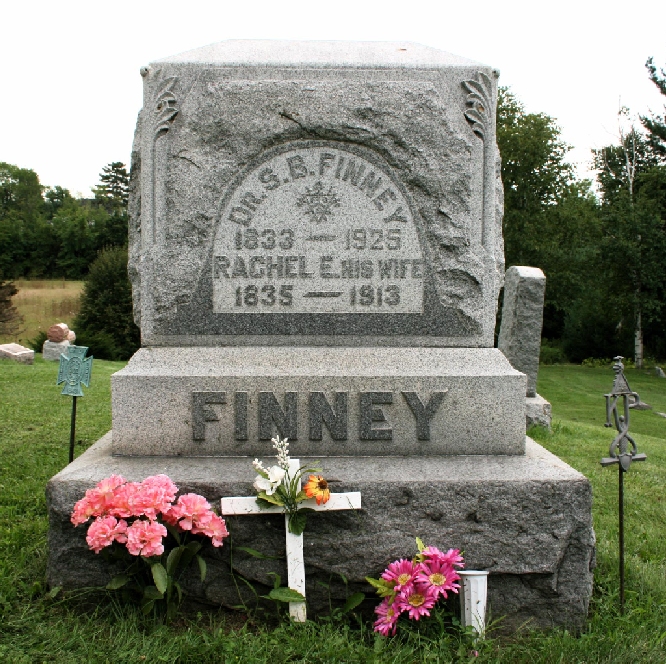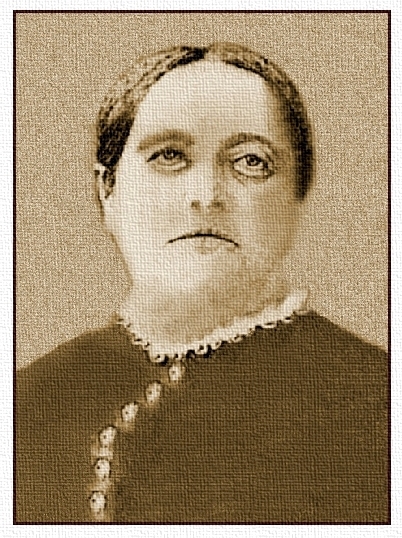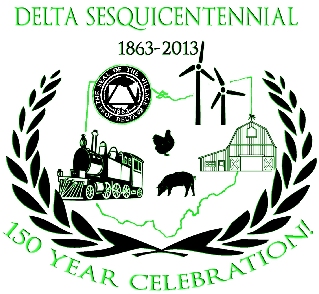
"Portrait of a Famous Fulton County Doctor"
by Amy Blondel McDonald
Wauseon Republican27 Sep 1962
Wauseon, Fulton Co., Ohio
Unquestionably, one of the most remarkable and colorful personalities in the history of Fulton County, Ohio was that of Dr. Samuel Bell Finney of Delta, Ohio, who, after a practice which spanned a period of over sixty years, died at the age of 92 and was not only one of the oldest practicing physicians in the county but was nationally and internationally known.
Samuel Finney was born on his father's farm near Millersburg, Holmes Co., Ohio on August 22, 1833. As a boy and youth, he attended the common schools of his district. Very early in life, he exhibited a marked and natural bent toward the study of plant life which the pioneer must often depend upon the simple remedies at hand to heal his ills and much lore was handed down from generation to generation. This preoccupation with plant life was interrupted by the Civil War of '61 to '65. Though married and a father, he volunteered in 1864 as a private and served creditably with Company K of the 166th Regiment, Ohio Volunteer Infantry.
Having married when he was about 24 years of age, he decided to seek a new home and at war's end, in April 1865, he brought his young wife, Rachel Lee Finney, and family to Fulton County, Ohio where they settled in Chesterfield Township. They traveled by wagon over the indifferent roads of the time, sometimes more trails, sometimes no roads at all. Arriving in the vicinity of Wauseon, enroute, they were so lacking in this world's goods that a kindly Wauseon miller staked them to a sack of flour.
Building a log cabin, the young Finneys began farming. Here in these "Oak Opening" as this section was then known, was a wealth of plants, herbs, roots and barks and young Finney again took to the study of plant life, concentrating on the curative values of botanical specimens, experimenting, and combining those which seemed to give the best results and do the greatest good. He began ministering to those who were sick and afflicted. Being able to help them gave him a deep personal satisfaction.
At best life was hard. Only 30 years had elapsed since the first settler had arrived and found this section largely a forest wilderness populated by friendly Indians. The hardy pioneers in this wild land had had the formidable task ahead of them, not merely of existing, but of establishing roads, schools and churches as well. The Finneys heir to the works wrought by the generation who had preceded them, set to in grim earnest to carry on. Parents of five children, three of whom died in infancy, they struggles to support their family and gain a toehold. In time, hard labor began to bring rewards. They acquired land in Pike Township and in 1884, moved to their own farm. They first lived in a little log house one half mile west and one mile north of Winameg, a small hamlet about three miles north of Ottokee, the county seat and about ten miles from Wauseon. There he opened an office in his home, carrying on what was to be his life's work of healing, the work he really wanted to do.
At first, almost unnoticed by his neighbors, people from everywhere began to drive in daily, asking for Dr. Finney's place. His name and news of his cures spread by word of mouth, first in Ohio and neighboring states and then farther a field in ever widening circles. It seemed nothing short of astounding that a name could draw so many to this out-of-the-way country crossroads.
Someone has said, in a measure facetiously, that for a lock of hair, one's age and one dollar, Dr. Finney would tell your past, forecast the future and diagnose your ails. Grateful patients have been known to proffer gifts in any era and an occasional gift of a lock of hair may have indeed been given him. The crux of the matter is that he had grateful patients, first by the dozen, then hundreds, then thousands, to the everlasting amazement of the good people of his neighborhood who, in this year of 1962, are still talking about him.
Besieged by letter and in person, he had to have more room and more help. Depending in part on neighbors who might use a little pocket money for gathering fresh herbs, roots and barks was out the question. In 1886 he built a fine home one half mile west of the Winameg cross roads on the north side of the road, also an office building with 6 bedrooms on the second floor and a tavern to serve those who came for a distance and could not return the same day. Hack lines had to be established to meet trains, running to this country hamlet, center of the fantastic interest, from Delta and Wauseon and sometimes Swanton. But many of his patients came to his office in their own buggies of surreys and travel over the roads of the time was not like it is today. Meals were served at the tavern and feed for the horses was available. All was done that could be done for his patient's accommodation.
He hired a staff of workers to gather, clean and process the herbs, roots and barks he needed and to operate the inn. He also acquired a secretary to handle his correspondence. It was one of the quirks of his nature that each of his workers was paid in full at the end of each day. All were kept more than busy at their appointed tasks. The Delta Atlas for February 19-26, 1887 reported that Dr. S. B. Finney in January received 2415 letters, posted 2224 letters, shipped out 800 boxes containing 1154 bottles of medicine and in addition dispensed 2707 bottles of medicine to his office patients.
An early letterhead stressed the "Dr. S. B. Finney, the great botanist of this age, uses no calomel, mercury, chloroform or other poisonous drugs", that "an estimated 780,000 patients from all parts of the U.S., Canada and Europe have been successfully treated by correspondence" and that "thousands of testimonials are on file. Chronic diseases are a specialty. When ordering, give name and age of patient, P.O. and Express office addresses. All consultations are free. Communications are answered daily. Do not forget to enclose stamps for postage."
An assistant secretary became necessary and the Doctor engaged a young Englishman, John Blondel, my father, on whose file of notes, clippings and photographs this sketch is based. This association continued until the Doctor's death.
The liquid medicines were dispensed in round quart glass bottles with corks and were shipped daily, cradled in straw in stout wooden boxes. Powdered medicine, according to prescription, were packaged and shipped along with bottled medicine. Roots, herbs and barks from other lands were bought from wholesale pharmaceutical firms and certain remedies were made up by outside pharmacists according to the Doctor's prescription. Originally, a month's supply cost $1.00 but later rose in price to $2.25 to $3.00. The liquid medicine was not unpleasant. The powdered medicine was very bitter and sometimes ordered in capsules. If the doctor sensed that a patient could not afford the price of a month's treatment, that patient would find his dollar bill wrapped around the bottle when he arrived at his home. Old soldiers, too, for whom the Doctor had a soft spot in his heart, found their money thus returned to them.
With the ever rising tide of correspondence, the hard-pressed secretaries were obliged to limit each letter to 8 lines. About one letter in every ten was from French Canada and was answered in French which was John Blondel's native tongue. Though an Englishman, he had been born in Guernsey, an island off the coast of France where the population still spoke French almost exclusively. Both secretaries used the then popular Spencerian script, writing an easy flowing hand. "Why were typewriters not used?" one is inclined to ask. The Doctor's clientele responded to the personal touch of a hand-written letter.
When answered, the letters in their envelopes were tied in packets and stacked in racks built up the walls of the office. At one time, someone estimated that there were 6 cords of letters on display. I, myself, recall seeing many square feet of wall space so covered. This eccentricity in addition to the Doctor's office manner in receiving patients and his style of conversation once termed "weird patter", left an undeniable and unforgettable impression. In this connection, a stamp collector would immediately think of the stamps affixed to the letters. There is a sequel to this. Long after Dr. Finney's death, I say a "cover" for which a neighbor had just paid $10.00, bearing Dr. Finney's address and a rare 3-cent green stamp. I turned it over and on the back was the writer's name, as I suspected, surrounded by the queer little squiggles of hieroglyphic-like markings which I had often seen the Doctor make over or under a patient's name. A personal shorthand, with meaning only for him? Who knows? In my father's old autograph album of 75 years ago, is what must be a rare autograph of Dr. Finney, complete with squiggle.
When money came along in this fever and ague-ridden land, it was to Dr. Finney of relatively little importance, a by-product of the work of healing which was important. He never prescribed medicine in whose healing powers he did not implicitly believe. He was a dedicated doctor. But the golden flow, while it abated somewhat in later years, never ceased up to the time of his death. My father recalled that at one time, the Doctor bought 40 acres of woods for $1600 and paid for it in just 16 days. Cash from his patients was a bit of a nuisance. To facilitate handling, he had a pocket for each of various denominations of bills and other pockets for small change. Patients coming to see him took numbered cards in which they were to be received by him. He often worked from four in the morning until ten o'clock at night. At one time, he brought well over a hundred children through a serious epidemic of some children's disease that usually took a heavy toll.
Dr. Finney was a tall, spare, comely man with dark hair and wore a moustache and full beard which, though graying as the years rolled by, he continued to wear all his life. He had high cheek bones and straight nose. He carried himself erectly and with a certain native dignity and professional air which, though pleasant, never invited intimacy. He often wore Civil War blue with a gold fob chain and lodge insignia draped across his vest as was the custom. (He was a member of the Knights of Pythias and the Grand Army of the Republic.) He wore no tie which may have been a masculine fashion of his day as many of those with him in group photographs wore none either. The accompanying photograph of the Doctor as a young man was taken by B. R. Richardson of Lyons, Ohio. The group photograph was taken in the spring of 1887 by Richardson and Mudge of Lyons. It shows an early morning group of patients. At the left rear is the Doctor's residence (still standing [1962]), his office building, center, and the tavern at the right. In the picture, Dr. Finney is the tall man to the right of the man with hat in hand. The road is a typical road of the day. In 1889, The Delta Atlas announced that Dr. Finney had closed a contract for the fine brick residence on Wood Street in Delta owned by Ward Barber, late of the firm of Barber and Fowler, and that he would commence arranging his correspondence so as to move after harvest. Some fine improvements on his new home were to be expected. The move was made in November. On the first day, the Doctor treated 375 patients and his cash receipts totaled $103.75 which was a young fortune in 1889.
About 1896, the Ohio Legislature enacted a law requiring every practicing physician in the state of Ohio to have a license from the State Medical Board in order to be able to practice medicine within the boundaries of the state. Those who had graduated from an accredited medical college could obtain the license by making application to the State Board and sending in their college diploma. Those who had no college degree but who could prove that they had been practicing medicine for at least ten years could, by consent of the State Medical Board, obtain a license and continue practice. Sponsored by Drs. Worden, Oliver Fletcher and John Wilkins of Delta, Dr. Finney made application. The secretary of the State Board, accompanied by Dr. Worden called at the Finney home saying he had been sent to make a personal examination and investigation of the Doctor's practice. Dr. Finney took them by lamplight to his office and told min to look things over especially several large books containing thousands of names of patients. He offered to answer any question but to him. Finally, the secretary said, "Dr. Finney, I have been sent to investigate many places of business all over the state, but this, your practice, beats anything that I have ever seen and when you go to bed tonight, lose no sleep about getting your state license."
As time went on the years took their toll, but the Doctor carried on in spite of failing strength. On October 28, 1921 something happened to him which should happen to no man, least of all one 88 years old. While alone but busy in his office, he was held up by four young bandits who knocked him down, gagged him so that he could scarcely breathe and bound his hands and feet with new leather straps. Then they robbed him of thousands of dollars in large denomination bills which he carried in king size billfolds, one in each hip pocket. The Doctor was rescued only just in time. The bandits were later apprehended and received prison terms but the money was not recovered.
Having served his era well, in the time and place allotted to him and in his own manner, Dr. Finney died April 1, 1925. He outlived his wife by several years but was survived by a son, E. Grant Finney, a daughter, Mrs. Thomas Kirkman, and ten grandchildren. He was a member of the Delta Church of Christ.
Immediate cause of death was cancer of the throat. He was up and around literally until his dying day.
In Doctors of Pike Township, History of Fulton County published in 1905 by the Northwestern Historical Association at Madison, Wisconsin and edited by Thomas Mikesell, are listed Dr. William Holland, Robert A. Moore, Dr. James S. Richards, the "Indian Doctor", and lastly Samuel B. Finney, "whose practice has been world-wide in late years, and who from poverty and obscurity has risen to wealth and fame, a mystery to all who visit him, and a severe thorn to the medical fraternity surrounding him. He is now located and in practice in Delta."
In History of Henry and Fulton Counties published in 1888 by D. Mason and Co. of New York and edited by Lewis Cass Aldrich, several paragraphs are devoted to the life of S. B. Finney, M.D. Quoting in part -- "It may seem a somewhat remarkable assertion to say that any physician possesses the power of analyzing disease by intuition, yet such cases are not wholly unknown, although they may be infrequent. However this may be, it is a well known fact that Dr. Finney possesses a rare gift of diagnosing and successfully treating physical diseases whether or not he has had an opportunity for a personal interview with the subject for treatment; and the throngs that constantly visit his laboratory and the still greater amount of communication by letter that calls for his professional skill attest the wonderful success of his methods of treatment. It is not alone the rich people of this world that receive substantial cures at his hands, but the poor as well, for it is a fact that Dr. Finney dispenses and distributes among all classes many thousands of dollars worth of his medicines each year. At home and abroad are his wonderful healing remedies sent, carrying joy and comfort into tens of thousands of homes and bringing to this kind benefactor the gratitude of as many hearts." After recounting his life, he goes on to say "It is now more than 20 years since this soldier-physician became a resident of Fulton County and during that time has achieved unbounded success and who is there to say that he has not deserved success?" Who, indeed?


Rachel LEE Finney, wife of Samuel
Calendar of Sesquicentennial Events
This Page Was Last Modified Thursday, 04-Oct-2012 13:41:28 MDT
Maintained by Mark Lozer, webmaster.
Send E-mail to:
lozer@fulton-net.com
